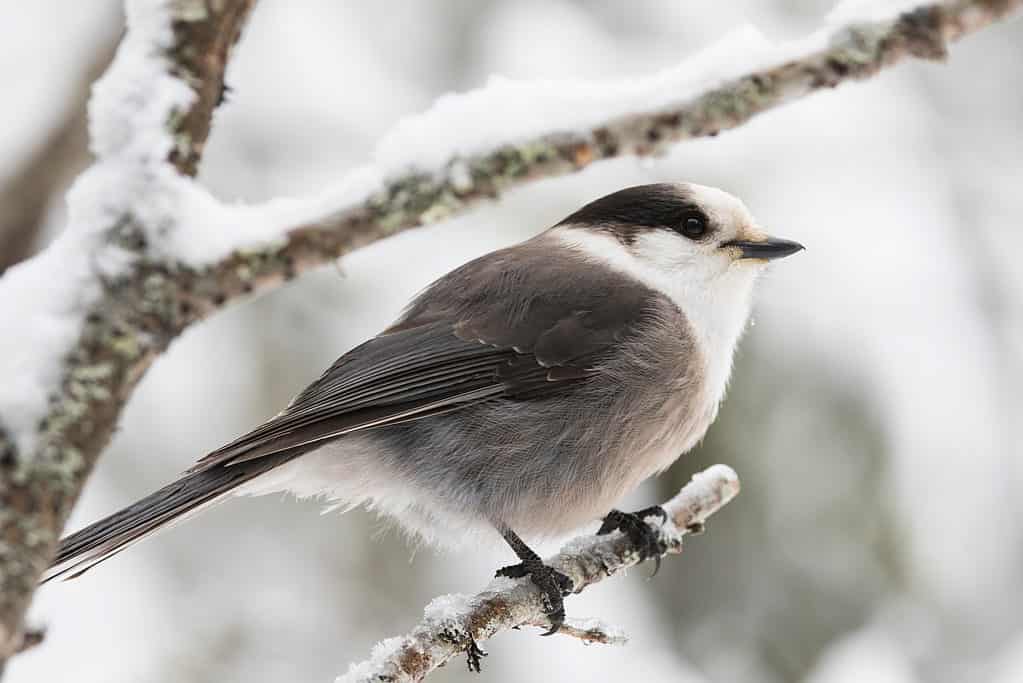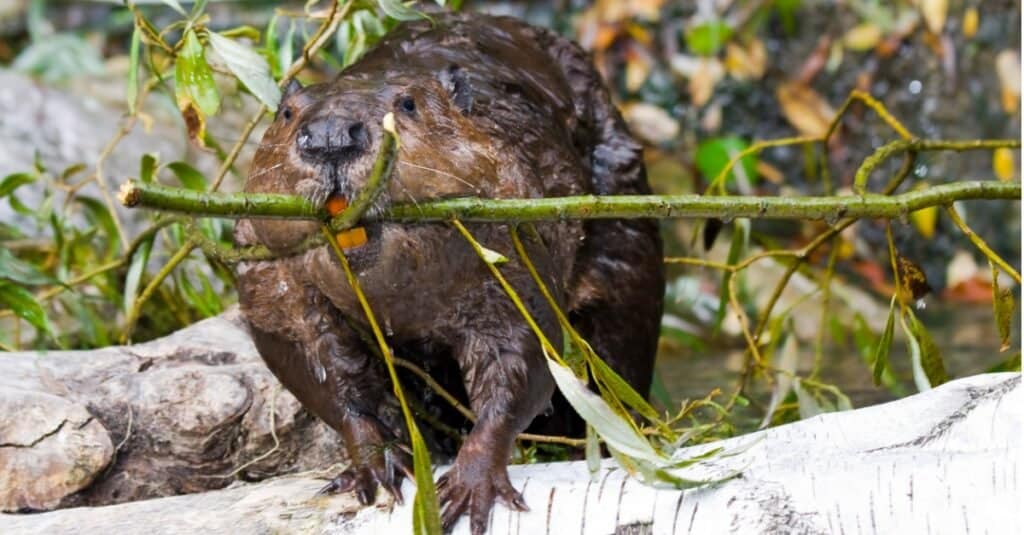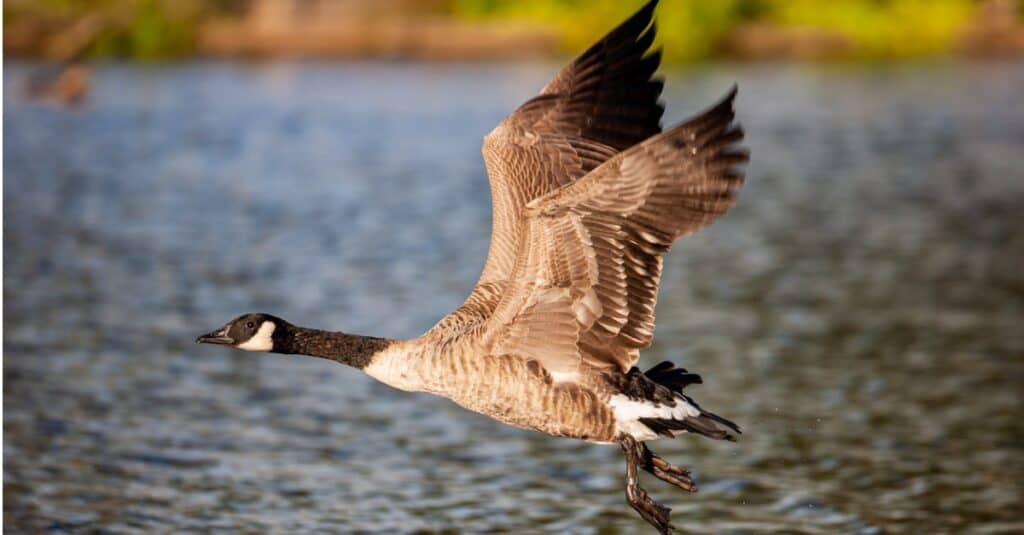If the Final Jeopardy answer was “Canadian goose” you may think the question was “What is the national bird of Canada?” Unfortunately, you would lose your wager and possibly go home empty handed. If the Canadian goose is not the national bird, then what is? Who decided the national bird of Canada? Is there any controversy over this national bird? Let’s find out the answers to these questions!
What is the National Bird of Canada?

The gray jay, or Canada jay, is a beautiful gray and white bird.
©Mircea Costina/Shutterstock.com
The national bird of Canada is the gray jay, a small songbird that looks like a black and white photo. This bird has a light gray back and wings, a darker gray head, and white/light gray breast. They are also called Canada jays. In fact, in 2018, the American Ornithological Society voted to officially change the name to Canada jay.
How did Canada Choose their National Bird?
The Royal Canadian Geographical Society (RCGS) held an online contest for the Canadian people to vote for the national bird. Nearly 50,000 people responded and the Canadian goose did not win, but it was one of the finalists, which included:
- Gray Jay
- Canadian goose
- Common loon
- Black-capped chickadee
- Snowy owl
Was there a Formal Debate Representing each of the 5 Finalists?
Instead of a political debate, each of the five finalists were represented by an ornithologist. A formal debate was held with each ornithologists presenting the top qualities of their bird to convince the crowds. As popular as the Canadian goose is, it migrates in the winter, while the gray jay stays in Canada. The common loon, which is featured on the back of the $20 bill, was another front runner. The gray jay ran on the platform of “Friendly and Intelligent” and was backed by the former prime minister’s wife. In the end, the gray jay got the most votes!
What is Another Nickname of the Gray Jay?
Another nickname for the gray jay is Whiskey Jack. The nickname doesn’t refer to the alcoholic beverage but comes from the traditional Indigenous Cree name Wisakedjak. The Cree shared stories of the shape-shifting gray jays that were tricksters but also wise teachers. To some First Nation tribes, the gray jay was a good omen in the morning, a sign of good fortune. Others believed the gray jay’s whistle was a warning sign to hunters that predators were nearby.
How Big are Gray Jays?
Gray jays are around 2.5 ounces. They are a bit smaller than a blue jay but larger than a robin. Their tails are long, and their beaks are short. They always look alert and are known to be quite curious.
How do Gray Jays Survive the Chilly Canadian Winters?
Gray jays are hardy birds. They don’t head south for the winter like Canadian geese. They are equipped with thick, fluffy feathers that keep their bodies warm, even during cold snaps of 20° below! One of their tricks for survival is using their saliva to “glue” food to tree branches above the snow line. These clever birds will eat a variety of foods including seeds, berries, fruit, and even small animals! They stash large amounts of food to help get them through the winter.
Where do Gray Jays Live?
Gray jays live in every province of Canada, which is one reason it was chosen as the national bird. Some occasionally spill over into Alaska and the lower 48 but mostly it is a bird unique to Canada. Their preferred habitat is forests, but they can adapt to urban living as well. This means they are often visible to a wide range of the Canadian population. They are not shy, so do not be surprised if one joins you at your picnic table!
Is a Gray Jay Smarter than a 5th Grader?
Gray jays are known to be intelligent birds. Their brain-to-body ratio indicates that they have an intelligence similar to that of dolphins. Their superior intelligence is one reason the Canadian people voted for the gray jay to represent them!
Is the Gray Jay Endangered?
The gray jay is not endangered; they are common throughout the country, living in every province. They are listed as “Least Concern” by the IUCN due to their large population size and vast range.
Are there More Gray Jays or Canadians Living in Canada?
The IUCN estimates the population of gray jays to be around 26,000,000 (as of 2018). The 2021 Canadian Census recorded 36,991,981, so there are around 11 million more people than gray jays in Canada.
What Other Animals Live in Canada?
Some of the iconic animals in Canada include the beaver, moose, caribou, bison, grizzly bears, polar bears, and walrus. Off the coasts you will find beluga whales, fin whales, sea turtles, dolphins, and even sharks!
What is the National Animal of Canada?

By building dams, beavers alter the flow of water to create ponds as habitats for a variety of new species.
©iStock.com/belizar73
The national animal of Canada is the beaver. The beaver received royal assent on March 24, 1975, and has been a part of Canadian history for years. Did you know beavers are rodents? They are not mammals like raccoons. Beavers are the second largest rodents in the world, but known to be hard workers (“busy as a beaver”). They are one of the few species that actually modifies their habitat to create their ideal environment. By building dams, they alter the flow of water to create ponds as habitats for a variety of new species. These animals wouldn’t otherwise survive in fast moving streams. Beavers are family animals that live together in their lodge and share food throughout the winter. The Canadian people are endeared by the hard working, family-oriented beaver.
Were Beavers Once an Endangered Species?
In Canada, by the mid-19th Century, beavers were considered endangered. The popularity of beaver-skinned caps almost did them in. Before the fur trade, there were around six million beavers in Canada. However, English and French traders sent thousands of beaver pelts back to Europe. Eventually, the demand for beaver hats slowed and the beaver population steadily grew again. On March 24, 1975, the beaver officially became the national animal and an official symbol of Canada.
Is the Gray Jay on the Canadian Coat of Arms?
A couple of animals are featured on the Coat of Arms, but the gray jay is not one of them. The gray jay was recently chosen as the national bird, long after the Coat of Arms was established. The royal lion of England and the mythical royal unicorn of Scotland stand across from each other. The lion holds the Royal Union Flag, and the unicorn holds the Royal French Flag. The shield also has the three royal lions of England and a royal lion of Scotland. Characteristics of the lion such as strength and courage make it a common symbol. For Scotland, the unicorn symbolizes “purity, innocence and power.”
Could Canada have a National Goose?

The Canadian goose would be a wise choice for Canada’s national goose!
©iStock.com/Wayne Marinovich
Technically, Canada could have a national bird and a national goose, after all they do have a national horse! But for now, they will settle for the gray jay as their national bird. Such a spirited, friendly bird is a great choice to represent the people of Canada!
Up Next
The photo featured at the top of this post is © Paul Reeves Photography/Shutterstock.com
Sources
- All about birds, Available here: https://www.allaboutbirds.org/guide/Canada_Jay/id
- Canada.ca, Available here: https://www.canada.ca/en/canadian-heritage/services/official-symbols-canada.html
- bbc.com, Available here: https://www.bbc.com/news/world-us-canada-38008160
- Canadian Geographic, Available here: https://canadiangeographic.ca/articles/meet-our-national-bird-the-gray-jay/
Thank you for reading! Have some feedback for us? Contact the AZ Animals editorial team.






